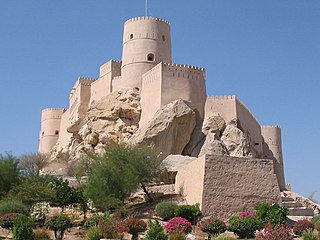
Oman is a site of pre-historic human habitation, stretching back over 100,000 years. The region was impacted by powerful invaders, including other Arab tribes, Portugal and Britain. Oman, at its height, held holdings that ranged from the Persian Gulf all the way south to the island of Madagascar, some notable holdings include; the island of Zanzibar, the city of Mogadishu and the city of Gwadar.
The modern-day African Great Lakes state of Tanzania dates formally from 1964, when it was formed out of the union of the much larger mainland territory of Tanganyika and the coastal archipelago of Zanzibar. The former was a colony and part of German East Africa from the 1880s to 1919 when, under the League of Nations, it became a British mandate. It served as a British military outpost during World War II, providing financial help, munitions, and soldiers. In 1947, Tanganyika became a United Nations Trust Territory under British administration, a status it kept until its independence in 1961. The island of Zanzibar thrived as a trading hub, successively controlled by the Portuguese, the Sultanate of Oman, and then as a British protectorate by the end of the nineteenth century.

Sultan is a position with several historical meanings. Originally, it was an Arabic abstract noun meaning "strength", "authority", "rulership", derived from the verbal noun سلطة sulṭah, meaning "authority" or "power". Later, it came to be used as the title of certain rulers who claimed almost full sovereignty without claiming the overall caliphate, or to refer to a powerful governor of a province within the caliphate. The adjectival form of the word is "sultanic", and the state and territories ruled by a sultan, as well as his office, are referred to as a sultanate.
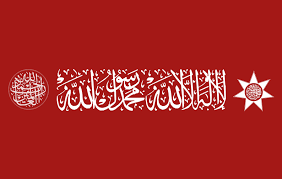
Banu Hashim is an Arab clan within the Quraysh tribe to which the Islamic Prophet Muhammad Ibn Abdullah belonged, named after Muhammad's great-grandfather Hashim ibn Abd Manaf.

The Sultanate of Muscat and Oman, also known briefly as the State of Muscat and Oman during the rule of Taimur bin Feisal, was a sovereign state that encompassed the present-day Sultanate of Oman and parts of present-day United Arab Emirates and Pakistan, in the second half of the 19th century and 20th century. Ruled by the Busaid dynasty, it was established as a result of the partition of the Omani Empire upon the death of its last ruler Said bin Sultan. The Sultanate transitioned into a new form of government after the palace coup of 23 July 1970 in which the sultan Said bin Taimur was immediately deposed in favor of his son Qaboos bin Said.

Tabora is the capital of Tanzania's Tabora Region and is classified as a municipality by the Tanzanian government. It is also the administrative seat of Tabora Urban District. According to the 2012 census, the district had a population of 226,999.
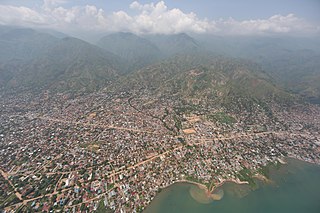
Uvira is a city strategically located in the South Kivu Province of the eastern region of the Democratic Republic of the Congo. Covering approximately 16 square kilometers and with an estimated population of 726,000 as of 2024, it borders Bafuliru Chiefdom and Ruzizi Plain Chiefdom to the north, Bavira Chiefdom to the south, and Lake Tanganyika and the Ruzizi River to the east. These rivers form natural boundaries between the DRC and Burundi. Located in the Ruzizi Plain at a low altitude, the city lies between Burundi's Congo-Nile ridge and the Mitumba mountains.

Mikindani is a historic coastal town located in Mtwara-Mikindani District of Mtwara Region in Tanzania. The name comes from the Swahili word mikinda which means "young coconut trees". Therefore, the term "Mikindani', literally means "the place where there are young coconut trees" in old Swahili language. Mikindani is part of the city of Mtwara and is governed by the Mtwara Mikindani Municipal Council. The site is a registered National Historic Site.

The Turu are an ethnic and linguistic group based in the Singida Region of north-central Tanzania who speak Bantu language Kinyaturu. In 1993, the Turu population was estimated to number 556,000. The current population of the Turu is now over 1,000,000. They speak the Turu language.
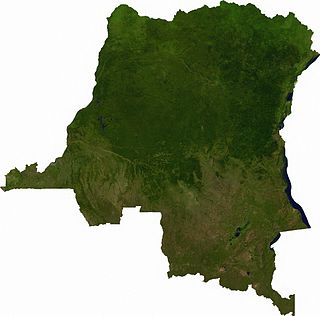
Articles related to the Democratic Republic of the Congo include:
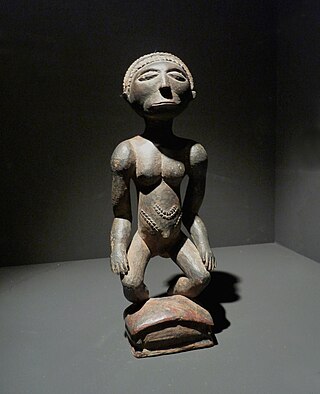
The Holoholo also known as Kalanga are a Bantu ethnic group that inhabit the shores of central lake Tanganyika. The majority of them live near Kalemie city on Lake Tanganyika in Tanganyika Province of the Democratic Republic of the Congo, and on the opposite shore of the lake in Uvinza District of Kigoma Region in Tanzania.
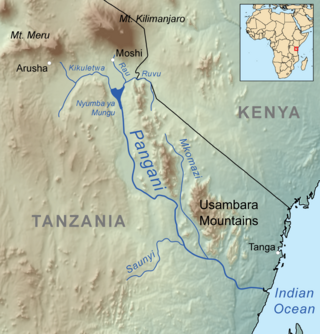
Kimweri ya Nyumbai or Shekulwavu Kimweri ya Nyumabi, also known as, , was the King of the Shambaa people of the Usambara Mountains in what is now Tanga Region of Tanzania between around 1815 and 1862. Under his rule the kingdom reached its greatest extent. However, disruptions caused by the introduction of firearms and the slave trade caused the kingdom to fall apart after his death.

Baraka, also known as Bala'a, is the main city and metropolitan center of the Fizi Territory located in the South Kivu Province in the eastern region of the Democratic Republic of the Congo (DRC). Baraka is bordered by the Lweba River to the north, the Mutambala River to the south, Lake Tanganyika to the east, and the Lu'e River, Efuma Mountain, and Makundu Mountain to the west.
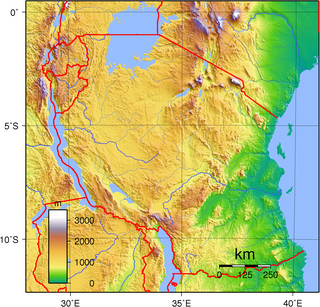
Mainland Tanzania refers to the part of Tanzania on the continent of Africa; excluding the islands of Zanzibar. It corresponds with the area of the former country of Tanganyika.
The Basimba are a Bantu-speaking community in Uganda. The name Basimba is a label of shared identity that predates the 13th century. Basimba has been alternatively associated with the people or their place of origin. The early Ovambo people applied the name to the whole group of the leopard totem clan, known as Bena Ngo in Zambia and Abe Ngo in Uganda.
The Goma, who also refer to themselves as Al ghamawiyyun in Arabic, are a tribe in the Kigoma Region in western Tanzania. They are a contingent of the Bantu tribe who are more commonly found in Tanzania and present-day Democratic Republic of Congo who migrated from the western shore of the Lake Tanganyika in Democratic Republic of Congo with origins from Sudan. They are the first group of the Bantu tribe to ever cross the Lake Tanganyika and also the first group to reside in the Urban District of Kigoma as its inhabitants. Following the Wagoma were Niakaramba (Kwalumona) from Cape Karamba and then Wabwari from Ubwari peninsula. The Kwalumona merged within Wabwari, identified themselves as Bwaris and settled north of Wagoma in Kigoma before resettling in Ujiji and its environs, where they formed a tribal Confederacy in Ujiji known as Wamanyema. The Wagoma crossed the lake early due to their invention of dug-out canoes mitumbwi ya mti mmoja curved from Mivule trees of Ugoma mountains from western shore of the Lake.
Vugha or Vuga is historic village located inside Bumbuli District of Tanga Region in Tanzania. The settlement was established as the capital of the Kilindi dynasty.

The Nyindu people are a Bantu ethnic group predominantly located along the Ulindi River in the northern, western, and southern regions, as well as near the Kilungutwe River in the Mwenga Territory of South Kivu Province in the eastern part of the Democratic Republic of the Congo (DRC). According to the 1970 census, the total population of the Luindi Chiefdom was 14,920. By 1977, estimates put the Nyindu population at 15,000, with a population density of 14.6 persons per square kilometer in the Luindi Chiefdom.














